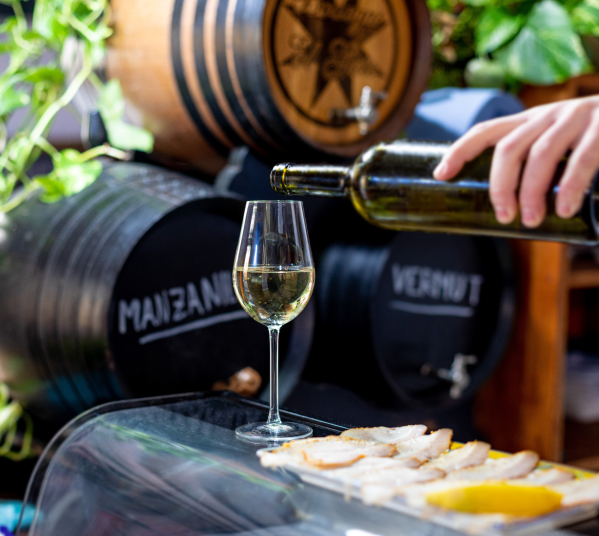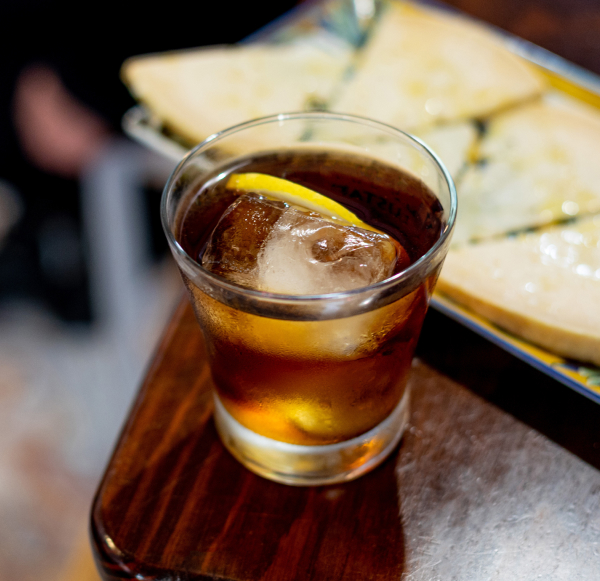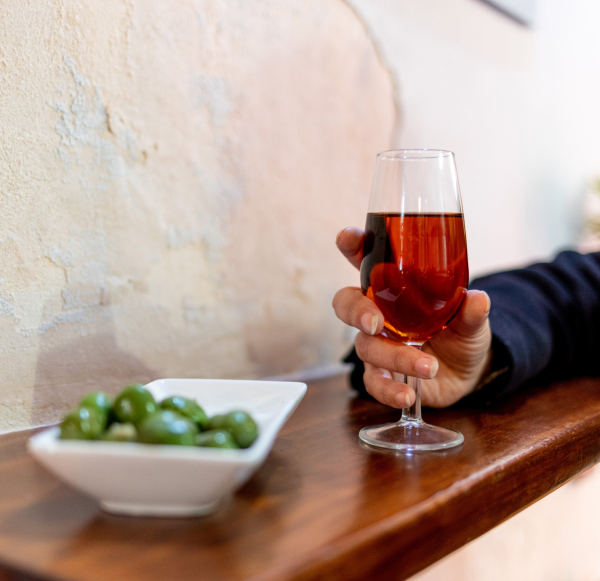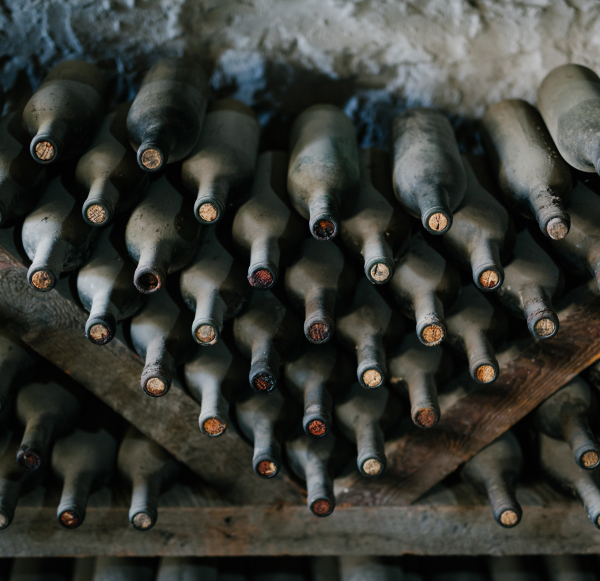Wines
classification
1) Generosos (Dry Sherry Wines): These are dry wines whose production process includes a complete fermentation of the musts, usually from Palomino grapes, at the end of which the yeast layer called flor (flower) appears in the base wine. There are different types:
- Fino: Wine made from Palomino grapes, biologically aged under the veil of flor. Ranging from bright straw yellow to pale gold in colour. A sharp, delicate bouquet slightly reminiscent of almonds with a hint of fresh dough and wild herbs. Light, dry and delicate on the palate leaving a pleasant, fresh aftertaste of almonds.
- Amontillado: A very unique wine due to its dual ageing process: biological and oxidative. Extraordinarily complex and intriguing. Ranges from pale topaz to amber in colour, subtle and delicate aroma; light and smooth in the mouth with well-balanced acidity; both complex and evocative with a dry finish. Lingering aftertaste with a hint of nuts and wood.
- Oloroso: Over 17 degree strong wines from the complete fermentation of palomino grape musts exposed to oxidative ageing. Ranging from rich amber to deep mahogany in colour. Warm, rounded aromas of dried fruits with toasted, vegetal and balsamic notes. Full flavoured and structured in the mouth; powerful, rounded and full bodied.
- Palo Cortado: A wine of great complexity which combines the delicate bouquet of an Amontillado with the body and palate of an Oloroso. Chestnut to mahogany in colour with a complex bouquet which harmonises the characteristic notes of Amontillados and Olorosos, citric (bitter orange) and lactic (fermented butter) notes. Deep, rounded, ample palate with smooth, delicate aromatic notes appearing in the aftertaste, leading to delicious lingering finish.


2) Generosos de licor (Sweet Sherry Wine): obtained from the traditional practice of cabeceo or blending of Generoso Wines with Naturally Sweet Wines, or in certain cases with concentrated must.
- Pale Cream: made from an organically aged wine – fino or manzanilla – to which rectified concentrated must has been added to give it a touch of sweetness. Ranging from yellow straw to pale gold in colour. In the nose it shares the sharp bouquet of biologically aged wine, with hints of hazelnut and dough. Light and fresh in the mouth but with a delicate sweetness which is pleasant on the palate.
- Medium: made from a blend or cabeceo of a fortified wine with a natural sweet wine or rectified concentrated must. Ranging from amber to dark chestnut in colour, medium sherry has a liquorous amontillado-like bouquet with the smoothly sweet notes of pastries, quince jelly or baked apple. It starts slightly dry in the mouth, gradually becoming sweeter to finish with a smooth vaporous aftertaste.
- Cream: made from a blend or cabeceo of fortified wines of oxidative ageing with a significant addition of natural sweet wine or rectified concentrated must. Ranging from chestnut brown to dark mahogany in colour with a dense, syrupy appearance. A strong oloroso bouquet in the nose combines with a hint of sweetness reminiscent of roasted nuts. Full bodied and velvety in the mouth with a well-balanced sweetness, seductively elegant with a lingering aftertaste.
3) Dulces naturales (Naturally Sweet): Obtained from must produced from over-ripe or sunned grapes, generally of the Pedro Ximénez or Moscatel varieties. This must, rich in sugars as a consequence of the sunning process of pasificación (which literally converts the grapes into raisins) is only partially fermented, with the aim of conserving most of its original sweetness. In order to achieve this, wine alcohol is added once fermentation is under way. The following types of naturally sweet wines are produced according to the variety of grape used:
- Pedro Ximénez: obtained from the overly ripe grapes of the same name which are dried in the sun to obtain a must with an exceptionally high concentration of sugar. Its ageing process is exclusively oxidative. A dark, ebony coloured wine with pronounced tearing and a thickness to the eye. In the nose its bouquet is extremely rich with predominantly sweet notes of dried fruits such as raisins, figs and dates, accompanied by the aromas of honey, grape syrup, jam and candied fruit. Later on, acquires toasted and liquorice tones. Velvety and syrupy in the mouth and yet with enough acidity to mitigate the extreme sweetness and warmth of the alcohol leading to a lingering, tasty finish.
- Moscatel: Made from the Moscatel grape exposed to the traditional soleo process, this wine comes from exclusively oxidative ageing. Ranging from chestnut to an intense mahogany in colour, with a pronounced density and tearing. The characteristic varietal notes of muscatel grapes stand out in the nose with the presence of the floral aromas of jasmine, orange blossom and honey suckle in addition to citric notes of lime and grapefruit and other hints of sweetness. It has a restrainedly sweet palate with predominant varietal and floral notes leading to a slightly dry, bitter finish.


4) Manzanilla: The D.O. “Manzanilla – Sanlúcar de Barrameda” is geographically located within the D.O. “Jerez-Xérès-Sherry” and shares with it both the Production Zone and the protection of the same Consejo Regulador. Both the grapes and production techniques employed are the same as those used for sherry.
They have their own identity due to the ageing under a layer of living yeast known as flor in the special microclimate of Sanlúcar, which is divided between the Barrio Bajo at sea level and the Barrio Alto, above sea level. Thus, such particular and distinct flor of Sanlúcar endows the organically aged wines from the local bodegas with special organoleptic characteristics
5) Vinos especiales: Bodegas belonging to the Denomination de Origin are custodians of authentic oenological treasures. These centuries-old wines are of such exceptional quality that they are rarely put on sale to the public. Enjoyment of these wines was traditionally the reserve of a privileged few.
It was in the year 2000, however, that the Consejo Regulador of the Denomination of Origin Jerez-Xérès-Sherry created two special categories of Sherry Wines of Certified Age: Sherry Wines of over twenty years of age (V.O.S.) and Sherry Wines of over thirty years of age (V.O.R.S.).
Another age certification system corresponds to Wines with an age between 12 and 15 years, at a medium level of ageing.
Finally, there are the Añada (Vintage) Sherries. This is a static ageing system (as opposed to the dynamic criadera and solera system) in which sherry wines from a specific harvest are separately aged.


